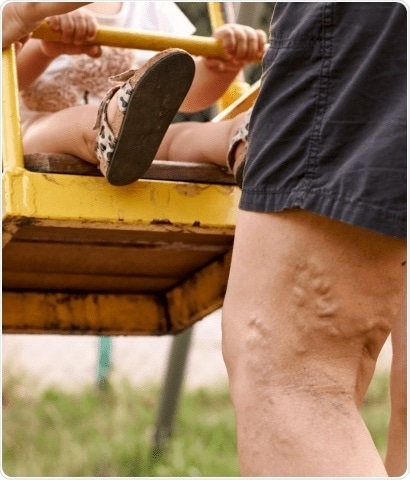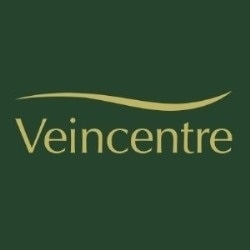Varicose veins are highly recognisable due to the presence of twisting, bulging veins on the feet and legs. These veins tend to become more pronounced and swollen as time progresses.

Image Credit: Veincentre
Varicose veins are a frequently occurring medical issue, with at least 1 in 3 people suffering from them at some point in their lives. Varicose veins are typically a sign of an underlying valve problem in the veins below the skin - these veins are responsible for feeding the visible varicosities.
Their presence can lead to a diverse array of other issues, for example, aesthetically displeasing thread veins, more prominent and painful varicose veins, or even skin ulcers and other skin conditions.
These issues vary in their impact and between individuals, ranging from self-consciousness and a reluctance to wear shorts in the summer to ulcers and bleeding.
Treatment options for varicose veins have improved considerably over the past 20 years. A range of minimally invasive techniques that aim to treat the vein from the inside (endovenous ablation) have been introduced, allowing patients to walk in, receive treatment and walk out.
These newer treatment approaches are used in conjunction with enhanced scanning protocols, avulsion treatments and foam sclerotherapy, offering improved success rates and fewer complications than historically utilised surgical stripping procedures.
There are minuscule valves present in veins which are responsible for controlling the direction of blood. When these valves are functioning correctly, they ensure that blood flows from the foot, via the legs and to the heart.
Should these valves fail, however, blood will be prompted to flow in the opposite, wrong direction and begin to accumulate in the veins. This causes the veins to swell, enlarge and eventually bulge out of the legs.
Failing valves within the veins lead to a condition referred to as ‘venous insufficiency’ – essentially, diminished drainage through the affected veins.
This condition may manifest in a number of ways. It may cause spider veins, which may lead to aching despite being primarily a cosmetic issue. There is also a risk of larger, blue-coloured reticular veins – these veins lie slightly deeper under the skin.
More serious failure may lead to varicose veins, with a risk of ulcers or other skin alterations occurring in between 1% and 2% of people over 65 years old.
Symptoms of varicose veins
Symptoms of varicose veins are frequently present in the legs; for example, itching, swelling, throbbing, aching, burning, restlessness, tiredness, cramping and varicose eczema. Elderly patients may also experience varicose vein bleeding, even after comparatively minor trauma.
The increased pressure associated with varicose veins can lead to skin damage and actual ulceration of the skin in more severe cases, which may take several months to heal without proper treatment.
Most patients with vein problems will experience a number of these symptoms, but some patients live with these for so long that they become accustomed to them. In these instances, patients only become aware of the symptoms related to their veins when they notice the absence of symptoms following treatment.
It is important not to ignore varicose veins because these may be indicative of an underlying problem. Varicose veins can also be the cause of a number of other issues.
Varicose veins are unattractive
Many people feel highly self-conscious about the aesthetics of their veins. They may choose to hide their legs from their partners, opt not to take part in sport or not be able to fully enjoy holidays or other leisure activities.
In some instances, varicose veins can affect people’s careers, with models or performers reliant on their image for their employment opting to receive treatments for varicose veins.
Varicose veins are painful
While varicose veins themselves do not normally cause pain, the increased pressure associated with them can impact individuals’ lifestyles. Common symptoms include tired or aching legs, itchiness, throbbing or restlessness. These symptoms can lead to significant skin damage and ulcers if left untreated.
Though the majority of patients suffering from varicose veins do not experience ulceration, many leg ulcers are linked to varicose veins because leg ulcers are caused by the same underlying issue that causes varicose veins.
Effective treatment of varicose veins therefore also mitigates this underlying cause, limiting the risk of leg ulcers.
Causes of varicose veins
Varicose veins can occur as a result of ‘venous insufficiency,’ whereby high pressure develops in thin-walled veins that can normally only accommodate low pressures.
Venous insufficiency can be caused by deep vein obstruction, muscle pump failure or valve failure.
Deep vein obstruction is typically the result of a recent or historic case of deep vein thrombosis (DVT). DVT is typically a result of poor flow in the leg veins; for example, following an operation, reduced movement in the leg (such as being immobilized in a cast) or being confined to bed due to sickness.
In a small number of patients, DVT may lead to long-term valve damage in deep veins – an issue that can be challenging to treat effectively.
Muscle pump failure has a tendency to occur where the calf muscles are very weak. Persistent muscle pump failure can also lead to valve failure.
Valve failure itself remains the most common cause of venous insufficiency and varicose veins. This may be the result of:
- Inherited valve defects – the most prevalent cause
- Hormone levels, such as during pregnancy
- Trauma
- Historic thrombosis
- Advanced age - varicose veins can occur at any age, however
- Excess body weight
- Any activity involving long periods of standing without moving
- Weak calf muscles
Reflux is able to pass through a valve when it becomes damaged, causing the vein below to stretch. This, in turn, prompts the next valve down to be pulled apart and fail, effectively causing a domino-type effect and leading to increasing amounts of valve failure. In time, a varicose vein will become prominent.
Rapid and efficient detection, localisation and treatment of reflux are the foundation of effective venous insufficiency management, including related issues such as varicose veins, spider veins, reticular veins and ulceration.
Diagnosing varicose veins
The only effective means of accurately verifying the underlying cause of varicose or thread veins is the use of a colour duplex ultrasound scan performed on a patient’s legs. This full and detailed scan is key to thoroughly assessing a patient’s veins and determining the most suitable course of treatment.
Ideally, the medical professional performing the treatment will also conduct the scan; for example, a consultant interventional radiologist, vascular surgeon or specialist venous nurse practitioner.
Preventing varicose veins
There is no way to wholly eliminate the risk of valve problems with the potential to cause varicose veins. This condition can arise at any point during a person’s life and is typically determined by family history.
The inheritance pattern for varicose veins is not straightforward, however. Certain family members may exhibit substantial varicose veins at a young age, while other family members do not experience these at all.
An underlying valve problem can lead to other factors such as pregnancy, hormonal cycles and standing for long periods causing the veins to enlarge more rapidly. It should be noted, however, that these veins often revert to normal after pregnancy.
Individuals may opt to seek or delay treatment based on a range of factors, such as their concerns around appearances and/or symptoms, as well as potential benefits or risks from the necessary procedure.
Significant numbers of patients live with varicose veins for many years without seeking treatment, and in some cases, even large bulging veins may not exhibit any negative symptoms.
The most effective means of preventing varicose veins is the treatment of any underlying problems via an advanced, minimally invasive technique.
Treating varicose veins treatment is the only way to confidently fix this problem and prevent any worsening of the veins, but it may be possible to alleviate the symptoms using a number of approaches:
- Improving drainage from the legs while standing by wearing compression stockings
- Ensuring calf muscles pump the blood back toward the heart via regular exercise - this stops the blood pooling within the veins
- Elevating the legs when sitting or lying down
- Avoiding standing for extended periods
- Maintaining a healthy body weight in order to minimise pressure on the veins
Treatment of varicose veins
It can be difficult to justify varicose vein treatment via the NHS because this is not always necessary. For example, suppose varicose veins do not cause any notable discomfort. In that case, they are not a cosmetic issue, and they are not deteriorating at an advanced rate, then it may not be necessary to seek immediate treatment.
Despite this, it is advisable to address varicose veins in the longer term because the associated increased pressure over time may lead to a deterioration in skin quality which may, in turn, result in a painful varicose ulcer if left untreated.
Veincentre supports patients to manage vein problems by treating their underlying root cause initially. This is done by identifying and eliminating veins containing faulty valves prior to treating any visible varicosities.
Eliminating the root cause offers symptomatic relief while reducing visible varicosities and preventing treated veins from returning.
In 2014, the National Institute of Health and Care Excellence (NICE) recommended that patients be offered minimally invasive treatment rather than surgery.
Veincentre has been treating patients without surgery for more than 17 years, however. The company’s approach means that general anaesthetic is not necessary and all treatments are minimally invasive and informed by accurate medical imaging such as colour duplex ultrasound.
Patients are simply able to walk in, receive treatment and walk out again.
About Veincentre
 Veincentre are the UK’s leading varicose veins specialists using Gold Standard, minimally invasive techniques, with 15 clinics nationwide.
Veincentre are the UK’s leading varicose veins specialists using Gold Standard, minimally invasive techniques, with 15 clinics nationwide.
At Veincentre, we provide the most effective, proven treatment and the highest quality of care that is accessible to everyone. We treat the cause, not just the symptoms! All our treatments are minimally invasive – walk-in, walk-out, require no general anaesthetic, no surgery and no time off work.
The most important aspect of care for any condition is the ability and attitude of the team of doctors and nurses looking after you. We have headhunted some of the most experienced and respected vein specialists in the UK. By choosing Veincentre, you can be assured that discomfort will be minimised, outcomes will be optimised, and you will be looked after by a team who really care for you
From your initial point of contact you will be communicating with our patient advisers, who only deal with patients who suffer from varicose veins so are all highly experienced and can confidently answer all of your queries or provide any advice.
Start your journey to healthy veins and happy legs…
Sponsored Content Policy: News-Medical.net publishes articles and related content that may be derived from sources where we have existing commercial relationships, provided such content adds value to the core editorial ethos of News-Medical.Net which is to educate and inform site visitors interested in medical research, science, medical devices and treatments.